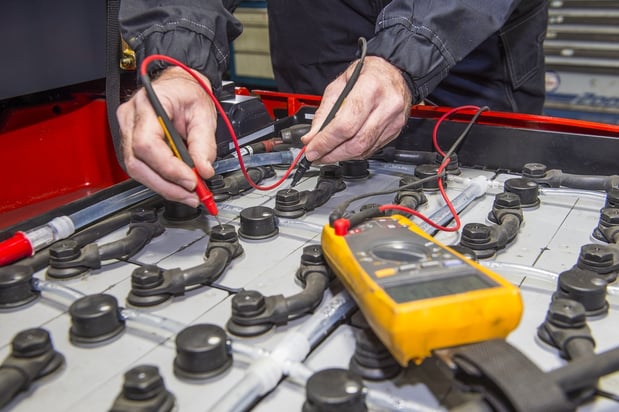
Forklift battery maintenance is important to your business. What you don't know about maintenance could cost you in the future in terms of safety, cost, and the life of your forklift. An integral part of forklift battery maintenance includes watering your batteries, and our team at Brauer is here to show you how!
Here's our Forklift Battery Watering video. If you'd rather read, the transcribed text is below.
Safety First
First, ensure the person watering the forklift batteries is wearing appropriate personal protective equipment (PPE), which typically includes protective gloves, a protective apron, and eye protection.
These simple pieces of equipment can greatly reduce the potential skin contact with the electrolyte.
Batteries should also be watered in an appropriate area that includes a stable and level surface, adequate ventilation, and absence of spark- or flame-producing items.
While the electrolyte itself isn't flammable, sparks or flames are possible due to any residual hydrogen gas inside the battery cell from the charging process.
Lastly, if there are any bystanders in the area, please be sure to make them aware of the situation so they are able to use caution as well.
Visit OSHA's website to learn more about safety precautions.
Watering a Forklift Battery
There are two basic ways of adding water to batteries.
1. Adding water directly into individual cells by water guns or nozzle.
2. Using a battery watering system.
While there are a variety of watering system brands, they all function similarly.
Adding water directly via water gun or nozzle:
In a conventional charging application, the first step is to make sure the battery is fully charged. This is important because as the battery charges, the electrolyte level rises slightly. If the battery had been watered before the charging process, the level of the electrolyte could increase to the point that it spills out of the top vent, resulting in an acid spill, which can cause damage to the battery or forklift.
1. Remove the vent cap or cell cap on every cell. If you can see the electrolyte covering the top of the protective splash plate, it doesn't need water. If the electrolyte level is below the splash plate, water is required.
2. Ensure your watering gun or nozzle is adjusted correctly for the battery requiring water. On most models, you enter the tip into the battery until it contacts the splash plate.
3. Adjust the depth indicator until each cell is watered to the same level.
4. Activate the water flow on your device.
These devices are designed to shut off water flow on back pressure. This means when the water level reaches the tip of the gun or nozzle, the flow will shut off automatically. This is your indicator to move onto the next cell.
5. Repeat this process until all cells are watered.
6. Close and retighten all caps.
Using a battery watering system:
Watering systems are designed to speed up the watering process, remove the need to take the battery off of a forklift, and minimize some of the other apparent hazards in the watering process.
While PPE standards are a bit more relaxed with a watering system, good safety practices are always recommended.
1. Remove the dust cap of the watering system you have equipped. Attach the watering system to the water source.
2. Activate the water flow on your device.
3. Monitor the flow indicator on your watering device. It will shut off when each cell has the appropriate amount of water.
4. Disconnect the watering system and device.
While watering systems are designed to reach every cell, we recommend double checking each cell to ensure it is at an adequate level.
Conduct a visual inspection
Regardless of which process you use, it is always good practice to conduct a good visual inspection of the battery every time you water it.
Typically you should check the condition of battery cables. They should be free of exposed copper and not have excessive kinks or cuts in their protective case.
Make sure the connectors are not cracked or broken.
Evaluate the overall cleanliness of the exterior of your battery. Excessive corrossion can allow shorts to exist between the battery and the forklift.
If any of these conditions are found, they should be corrected by a qualified battery service provider.
Watering isn't the only maintenance that is required for industrial batteries, and planned maintenance and washes are important ways to maintain your batteries.




